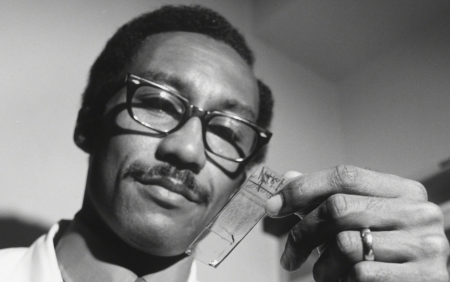
St. Jude scientists help show how new gene editing techniques can correct the mutation that causes sickle cell disease
The novel approach, developed in collaboration with the Broad Institute of MIT and Harvard, is a hopeful step on the path to a cure.

April 27, 2023 • 2 min

Scientists at St. Jude Children’s Research Hospital and the Broad Institute of MIT and Harvard have shown a promising way to correct the gene mutations that cause sickle cell disease, an exciting step forward in the work towards a cure for the debilitating disease that affects roughly 100,000 Americans.
The researchers showed a precise genome editing approach, prime editing, can change mutated hemoglobin genes back to their normal form in sickle cell disease patient cells. The findings were published this month in Nature Biomedical Engineering.
“We have identified what might be the next wave of therapies for genetic anemias,” said co-author Mitchell Weiss, M.D., Ph.D., chair of the St. Jude Department of Hematology. “We took the newest cutting-edge genetic engineering technology and showed that we could make meaningful gene edits for future therapies.”
Scientists have spent more than a decade trying to hone gene editing techniques to correct the mutation that causes sickle cell disease. The sickle cell gene mutation can form hard fibers inside red blood cells causing them to distort from healthy, round and plump cells into sickle or banana shapes. The abnormally shaped red blood cells cannot move through blood vessels easily, so they can get stuck, preventing the crucial delivery of oxygen to some organs and tissues and causing debilitating, sometimes life threatening, pain crises.
Though the study showed the potential benefits of using prime editing to cure genetic anemias, there is still much work to be done before it can move beyond research models in the lab to help patients in clinics.
“It will require extensive manufacturing development, process optimization and safety assessment. But the proof of concept is there,” said co-corresponding author Jonathan Yen, Ph.D., of the St. Jude Department of Hematology. “Our work now opens the door to developing cures for many hematological diseases.”
Over the last 60 years, doctors and researchers at St. Jude have helped improve the care and understanding of sickle cell disease.
It was on this campus in Memphis where an African American doctor, Rudolph Jackson, arrived in 1968 and developed community outreach programs serving sickle cell-affected families. Within a few years, Jackson’s work had amassed such recognition and stature that the federal government asked him to help establish a national program for the treatment and care of sickle cell patients.
A St. Jude patient was the first in the world to be cured of sickle cell anemia through a stem cell/bone marrow transplant. And work by scientists and researchers at St. Jude also helped show that using the drug hydroxyurea daily in children with sickle cell boosts fetal hemoglobin levels and can greatly reduce the frequency of hospitalization for pain crises.
Click here to learn more about this research.

















